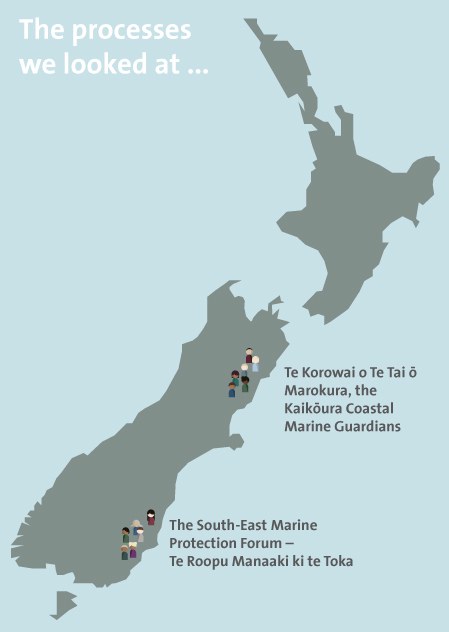Overview
E ngā mana, e ngā reo, e ngā karangarangatanga maha o te motu, tēnā koutou.
New Zealand’s marine environment covers over 4 million square kilometres of ocean and is home to more than 15,000 species, many found only here. To iwi and hapū, water is taonga. The marine environment is also used for a range of popular activities such as swimming, fishing, and boating. For economic purposes, this marine environment supports important economic activities, including commercial fishing and aquaculture, hydrocarbon exploration, extracting mineral deposits, tourism, and biotechnology.
New Zealand has 44 marine reserves. The first of these was established in 1975 at Goat Island, north of Auckland. Proposals for establishing new marine reserves have been infrequent. As a result, many of New Zealand’s coastal regions have little or no marine protected areas. Only 0.4% of the mainland territorial sea has marine reserves.
Decisions to establish marine reserves, in effect, prioritise access to, and use of, parts of the marine environment. Those decisions need to consider and balance the unique circumstances of different areas, including communities, biodiversity values, and social, cultural, and commercial interests.
We looked at how two groups used two different processes that generated advice to Ministers for establishing marine protection, including marine reserves. The two groups were the South-East Marine Protection Forum – Te Roopu Manaaki ki te Toka (the South-East Forum) and Te Korowai o Te Tai ō Marokura, the Kaikōura Coastal Marine Guardians (Te Korowai).
Each group used a process that was different in terms of its origin, purpose, scope, and expected outcomes. We examined how inclusive, transparent, and well informed the processes were to identify lessons that could be applied to support the establishment of other marine protection measures. We did not look at the biodiversity objectives of the respective processes.
Main findings
Establishing marine protection is not easy. Approaches to establishing marine reserves and marine protected areas are fraught with tension and have historically taken a long time.
Te Korowai used a community-led process that, with support from government agencies, prepared a marine strategy for the Kaikōura coast. Te Korowai met its community’s expectations for being inclusive, well informed, and transparent. Although the process took time and commitment, many participants in Te Korowai told us that they are proud of what Te Korowai achieved.
The South-East Forum was established April in 2014 to make recommendations to establish a network of marine protected areas consistent with the Marine Protected Areas policy. The South-East Forum mostly met our expectations for inclusiveness, being informed by the best information that was available at the time, and achieving a good level of transparency. However, there are some practical lessons for agencies to take note of to improve future Marine Protection Planning Forums. Roles and responsibilities need to be clear and followed by all, the criteria for selecting Forum members need to be transparent, and information needs to be prepared in advance and provided in a timely way. In my view, getting these aspects right will reduce frustration and support better outcomes.
Despite the South-East Forum largely meeting our expectations, our work highlighted how some aspects of the guidelines for implementing the Marine Protected Areas policy are not supporting the achievement of New Zealand’s marine biodiversity objectives.
Guidelines to implement the Marine Protected Areas policy are limited
In my view, aspects of the implementation guidelines are too restrictive. They limit the marine protection tools that can be recommended to Ministers, and state that Marine Protection Planning Forums should not be diverted by Resource Management Act 1991, aquaculture, or fisheries management matters. However, these matters are important to many New Zealanders. In practice, some of the South-East Forum members did not feel that recommendations to the Ministers could adequately address the concerns of the people they represented. As a consequence, some members’ participation and confidence in the South-East Forum was undermined, contributing to the creation of factions in the South-East Forum that appeared, at times, to operate in an adversarial way.
Our findings, the fact that Marine Protection Planning Forums have been attempted only three times since 2005, and that many of New Zealand’s coastal regions have little or no marine protected areas, support my view that aspects of the implementation guidelines make it difficult to achieve New Zealand’s marine biodiversity protection objectives.
In my view, New Zealanders would value an approach that encourages and enables communities to better support marine protection measures. A more flexible way needs to be found to balance the views and values of those with an interest in the marine environment. This is to establish a sustainable level of protection for New Zealand’s marine biodiversity that is consistent with long-term stewardship of an important natural resource.
I encourage the Department of Conservation and the Ministry for Primary Industries, as the stewards of an important natural resource, to consider how any reform to marine biodiversity protection legislation, policy, or planning could support greater collaboration between parties, and ultimately protect New Zealand’s unique marine biodiversity in a more effective way.
I thank the members of the South-East Forum and Te Korowai and staff in the Department of Conservation and the Ministry for Primary Industries for their co-operation.
Nāku noa, nā,

Greg Schollum
Deputy Controller and Auditor-General
20 June 2019


